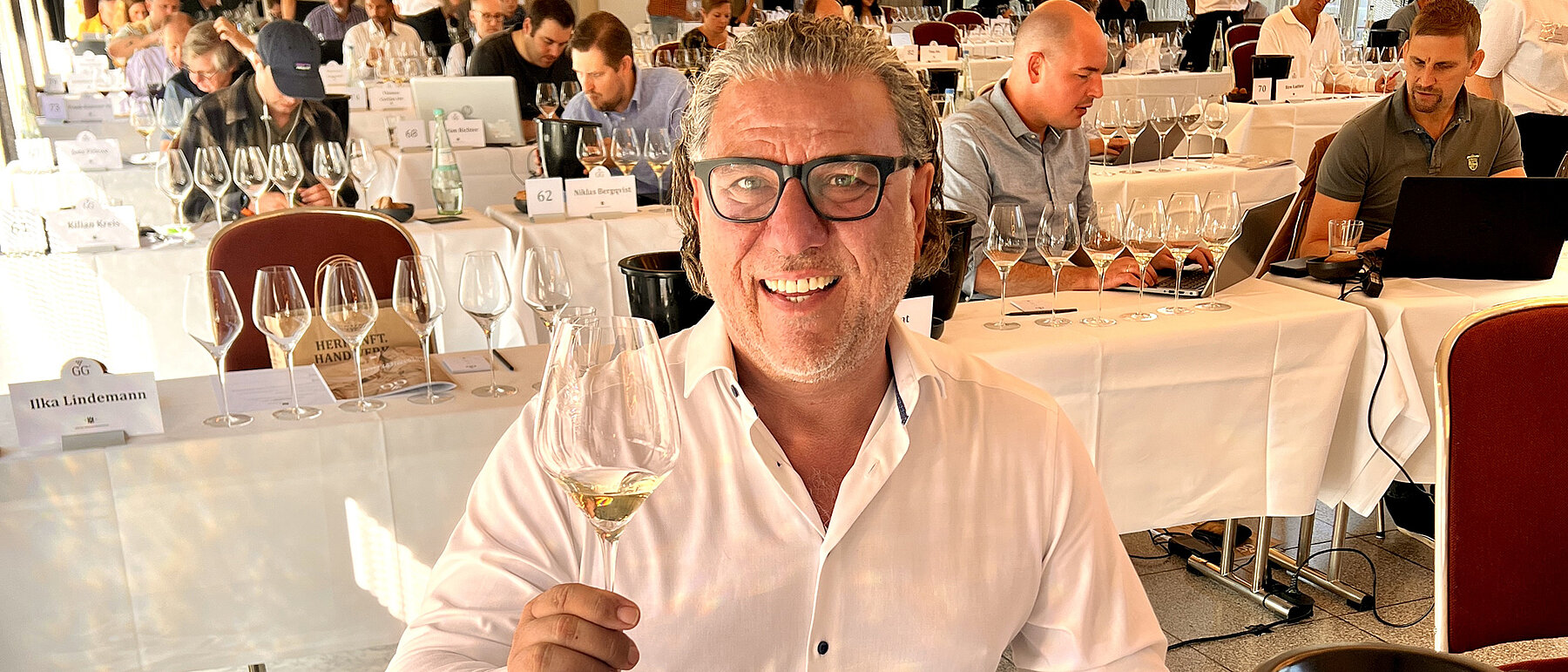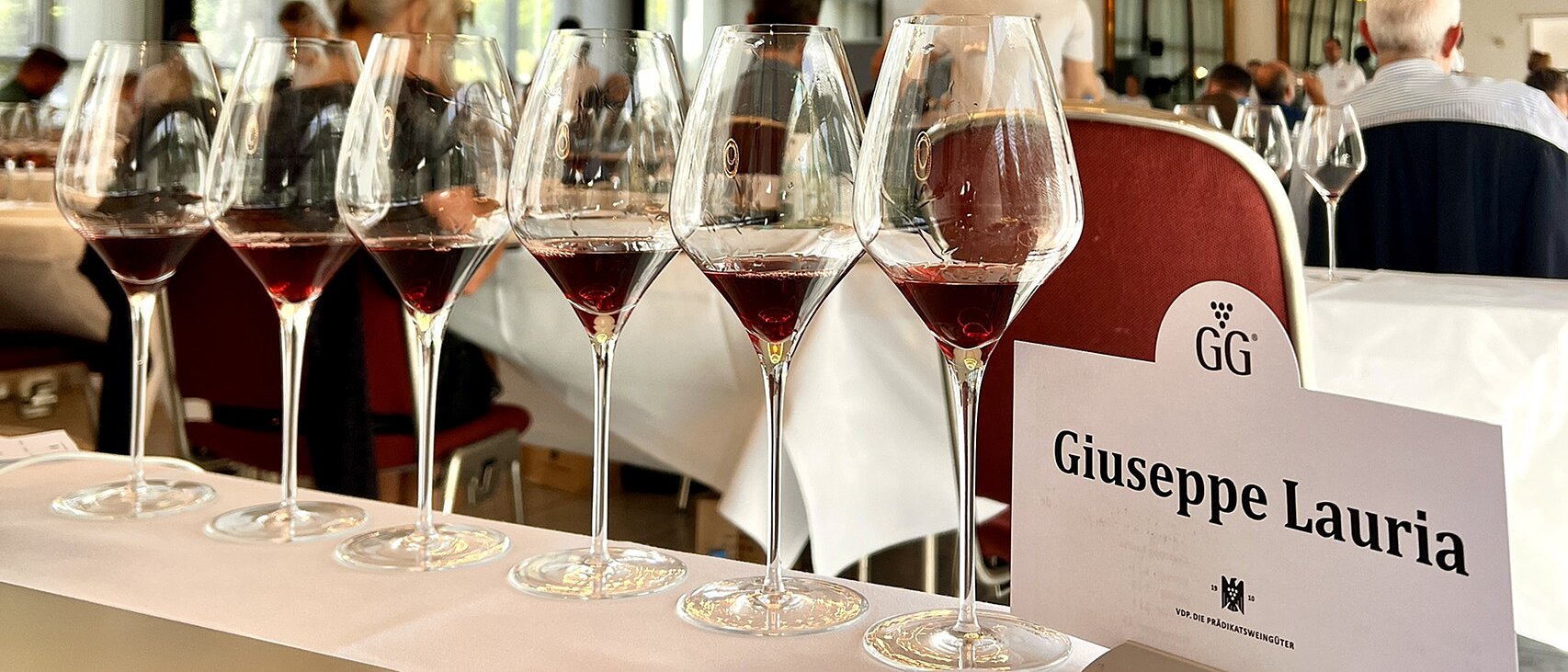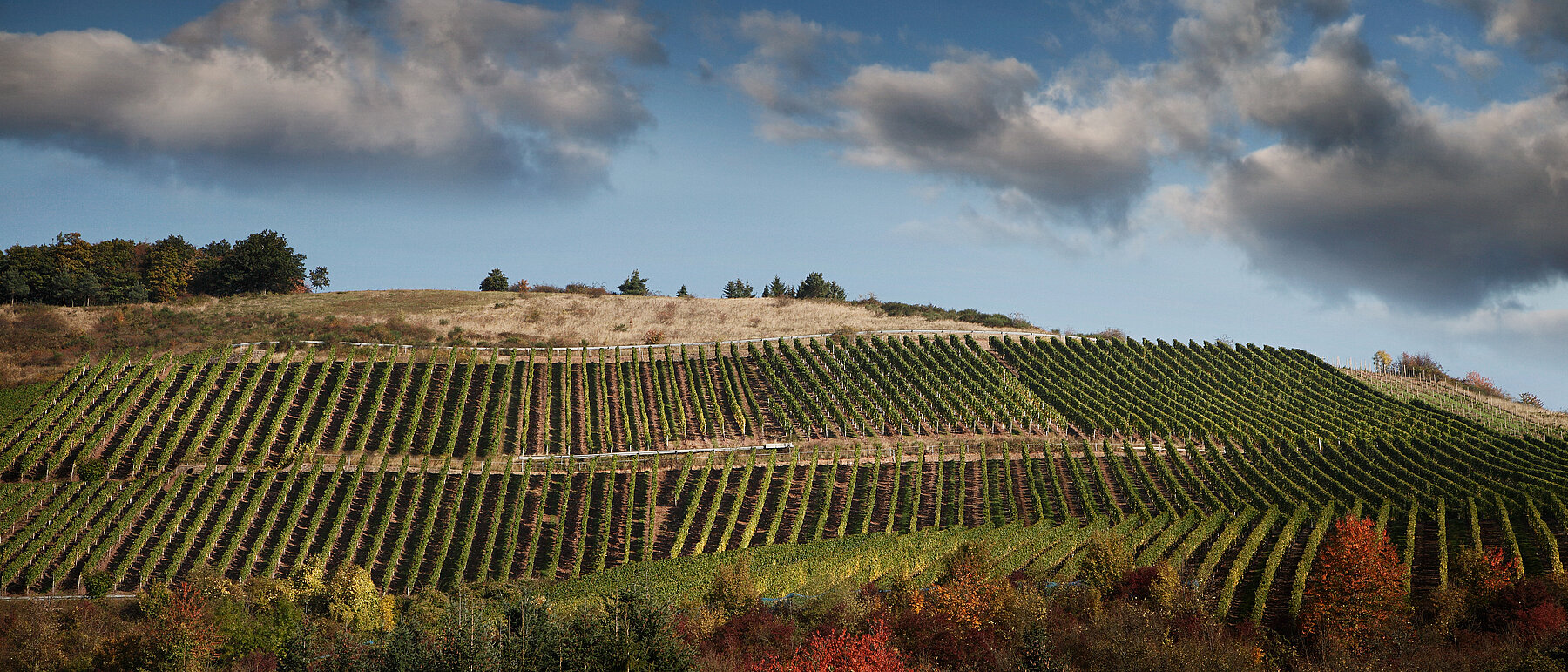Grosse Gewächse 2023: Heterogeneous, grandiose at the top & The new Pinot Noir dimension
A sunny and dry year in 2022 was followed by a year that was warm overall, but balanced thanks to a very good water supply. Many 2023 wines are wonderfully bright with expressive, multidimensional fruit instead of just citrus or superficial tutti-frutti stone fruit notes. The wet late summer also brought with it major rot problems, but those who selected strictly and brought the healthy grapes to the press quickly were able to produce excellent wines.
Anyone who thinks it was an easy-going vintage is mistaken. It is also not a vintage of the century as is often propagated, but a heterogeneous year despite all its goodness. Rarely before has the wheat been so separated from the chaff.
The challenge lay in bringing healthy grapes to the press. Extreme drought in places was followed by weeks of heavy rainfall, which in turn led to an extremely warm late summer. There was a threat of a second 2006 vintage with galloping rot, which the winegrowers (and also the tasters and consumers) were spared thanks to great manpower, speedy harvesting and somewhat cooler night temperatures. In addition, most grape varieties ripened almost simultaneously. This posed logistical problems for some winegrowers. With September temperatures of up to 30 degrees, they also had to collect their grapes in the cool night and morning hours so that the must did not end up overheated in the barrels. This was similar to the first week of September in 2024. In many places, the vineyards had to be heavily pre-selected, which on the one hand reduced the quantities, but on the other also ensured good quality and made some top qualities possible. At the top Rheingau winery Kühn, the average yield was 30 hl/ha. However, anyone who went through the rows of vines with a full harvester naturally had a lot of rotten grapes.
In addition to Riesling and the white Burgundy varieties, the winners of the vintage also include Silvaner. The winning regions are the Nahe, the Palatinate and Rheinhessen and, with regard to the Silvaner, also Franconia.
The 2022 Pinot Noirs are among the best that have been produced in Germany to date. Here, too, not all that glitters is gold, but overall the wines show fine fruit and tannin texture as well as more finesse and pressure. In any case, the days of excessive use of wood and superficial overripe aromas with jelly-like fruit seem to be a thing of the past.

The grapes were not as healthy everywhere as here in the Zellertal at the Battenfeld-Spanier winery.
Good template from nature
The 2023s are anything but homogeneous, but overall the vintage is characterized by freshness, lively lightness and, in the best cases, great radiance. Those who had their vineyards under control and were prepared to radically sort out the rotten grapes and make strict selections were able to make great wines. The risk of off-flavors was very high and a lot of corrections had to be made in the cellar, which could be tasted in some wines. They only appear good on the surface, often with striking fruit, but are ultimately insubstantial and soulless. "Nature's template was good, you had to know how to use and implement it," Klaus Peter Keller tells me during my visit. His collection is once again one of the best in the country, with racy beauty and finesse. He has thus given himself a present for his 50th birthday, as the year of his birth, 1973, was not really a big one. "That spurred us on even more," he tells me with joyful eyes.
Dönnhoff Senior is also clear: "The growing season was great, it was only hectic during the harvest because it was too warm. The negative grapes had to be sorted out very carefully," he says with the experience of 53 vintages.
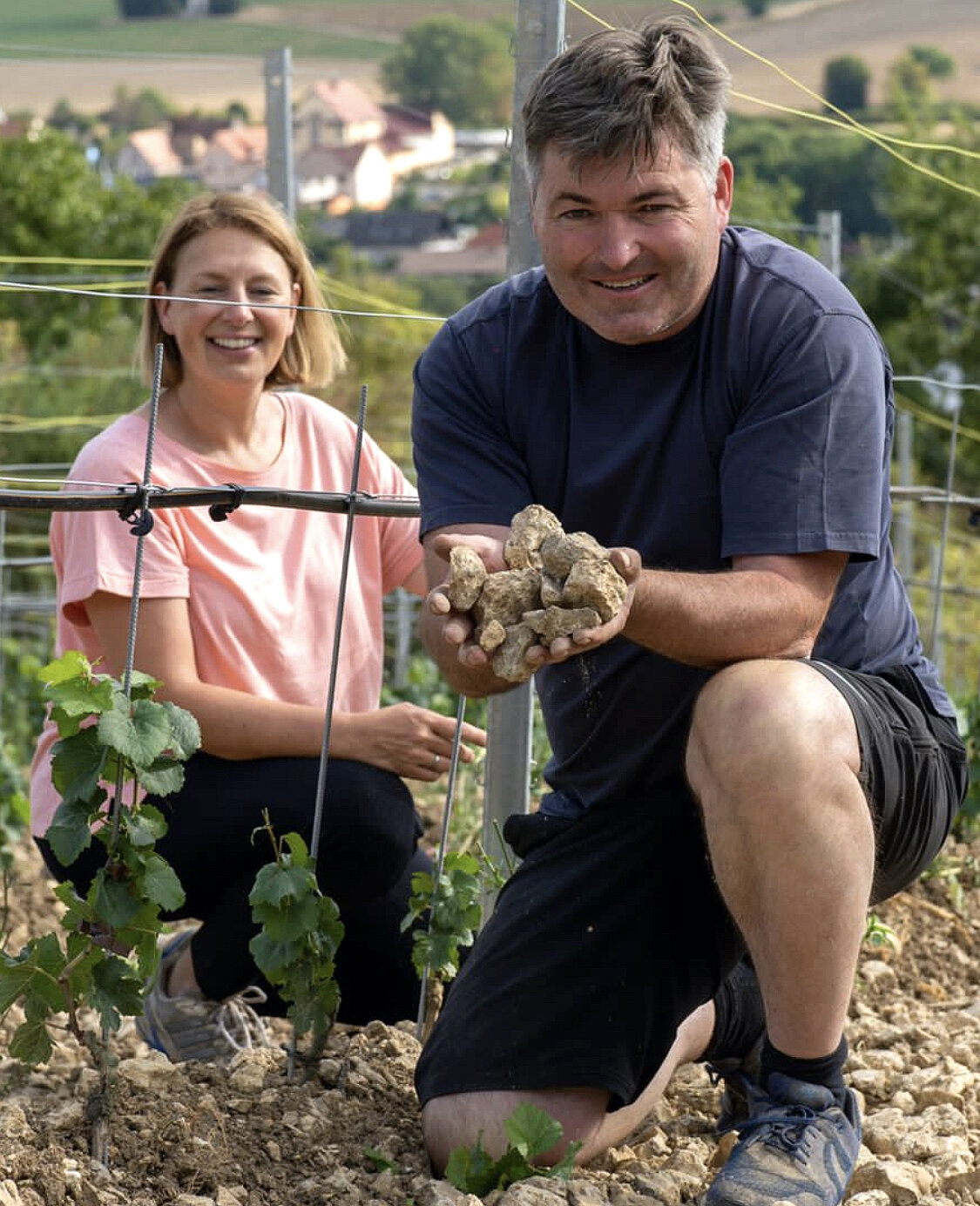
Klaus Peter and Julia Keller's collection is once again one of the best in the country.
The course of the year - "Very quickly too late"
A comparatively mild winter was followed by a good start to the growing season, which was in line with the long-term average. A period of sunny and dry weather in June led to a good and comparatively even flowering period.
The weather was very dry in June and most of July, which gave winegrowers hope for another hot vintage. However, the weather changed at the end of July and the rest of the summer was characterized by a lot of rain. The sunshine and temperatures remained within normal limits, allowing the vegetation to develop quickly.
Miraculously, the tide turned at the last minute and it stopped raining in many places in September and only started again at the end of the harvest. A sunny period followed, but it was also too warm to sit back and relax.
The pressure of rot made the harvest challenging, as the rapidly progressing rot reduced the quality of the grapes overnight. The only effective countermeasure was a speedy harvest so that the healthy grapes could be pressed quickly. Of course, this required sufficient harvest workers and good logistics.
Waiting for the noble sweet wines was particularly challenging as there was time pressure, because in addition to the "good" rot, there was also a lot of "bad" rot, especially gray rot.
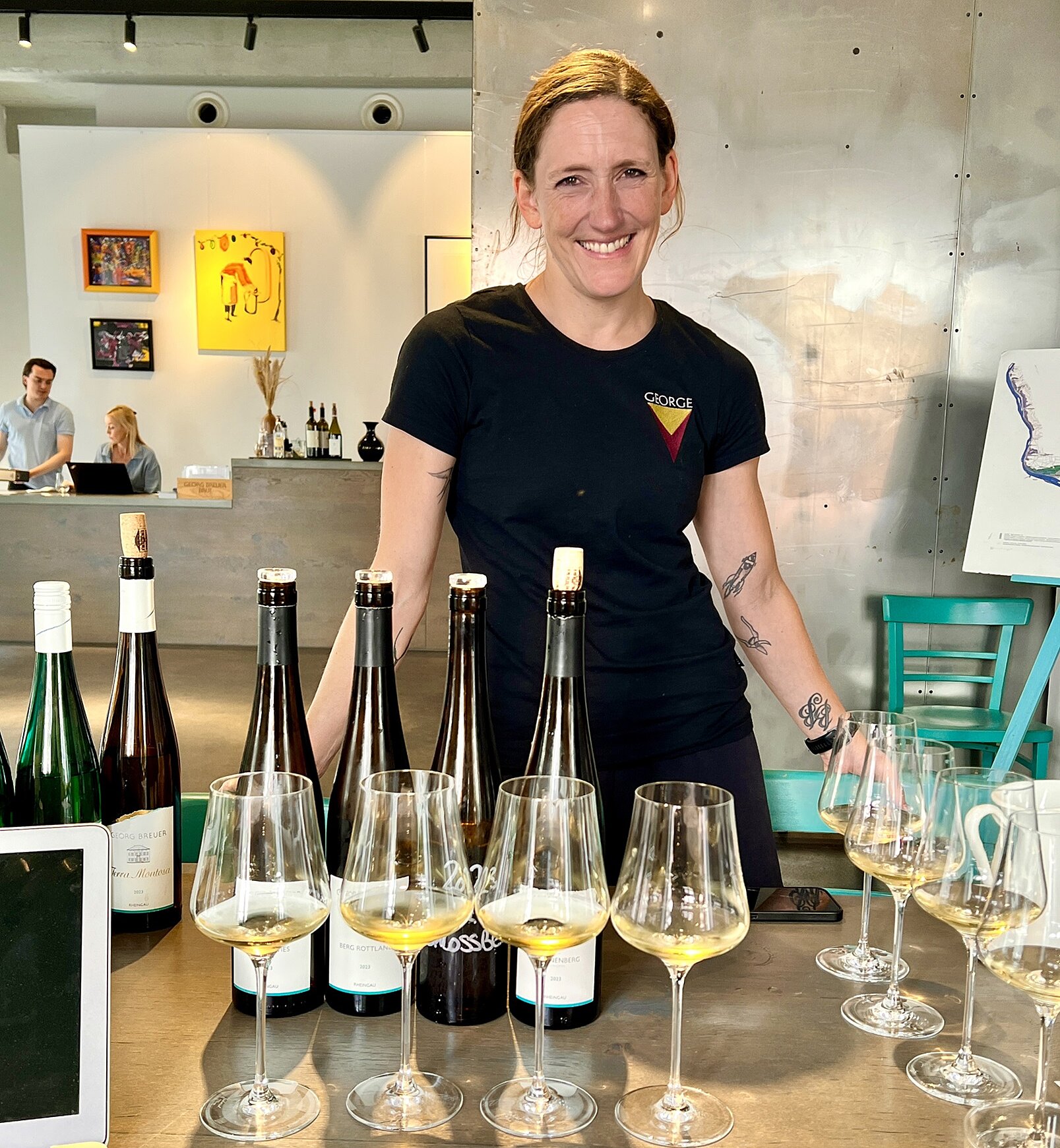
Theresa Breuer sees the year with one eye a laughing and a crying eye.
"It was very easy to be too late," summarizes Theresa Breuer, who sees the wet autumn with a smile and a tear. "The water was essential for the Rüdesheimer Berg and, thanks to the drainage, was easy to cope with, but it was sometimes too much for deep soils." This made for "wet feet", which - paradoxically similar to drought - had a slowing effect on the development of ripeness. And Frank Schönleber confirms: "In my childhood, we were never ready this early", he confirms the turbo harvest.
The wheat from the chaff - rarely so far apart
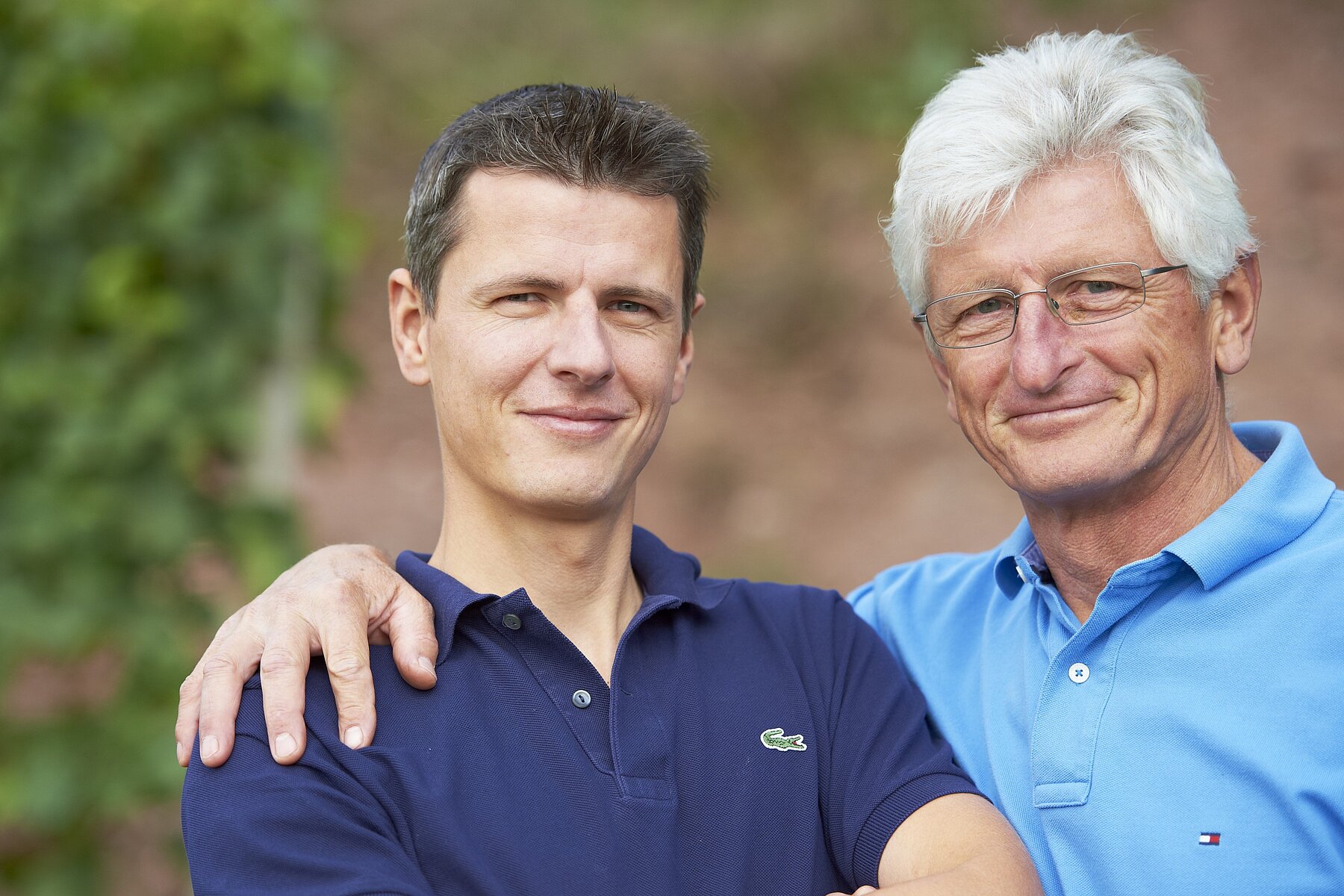
Werner and Frank Schönleber were once again able to achieve top quality thanks to a clever harvest strategy. (© VDP)
Another sign of the challenging year is the difference between the small peak and the rest. Characteristic of the vintage is the difficult handling of the sometimes heavy rainfall at the start of the harvest and the necessary turbo harvest. In addition to manpower, a clever picking strategy was also essential.
Frank Schönleber says clearly: "In fact, everything ripened at once and the time between just ripe and overripe was really short. That's why we first concentrated on the top qualities, where we only had to discard a few grapes". Then the majority of the estate wines were picked selectively, he explains.
This quickly revealed a clear difference in quality when tasting. Rarely have the top wines drifted so far away from the midfield. But even within an estate, the GGs were sometimes very heterogeneous. An indication that it was a challenging year for the terroir. This is why one should be very selective when buying wines this year. But the top wines are definitely worthwhile. There are a number of world-class wines among them.
Top winemakers: long in a league of their own
The best 2023s are typically tightly meshed with substance, finesse-rich fruit, coolness, finesse, tension and freshness. In our narrow top tier, there are grandiose wines from the usual suspects who have long been playing in a league of their own.
In Rheinhessen, these are Hans Oliver Spanier with the two wineries from the Wonnegau and Roter Hang, Klaus Peter Keller and Wittmann, but now also Gunderloch, Bischel and Wagner-Stempel as well as the new VDP member Knewitz.
On the Nahe, the best wines come from Tim Fröhlich, Cornelius Dönnhoff and Frank Schönleber and increasingly from Caroline Diel, who is finding her very own style.
But Joh. Bap. Schäfer and Kruger-Rumpf are also setting increasingly strong accents.
In the Rheingau, Kühn, Schloss Johannisberg, Weil (with some terrific sweet wines such as the Auslese Goldkapsel and the Trockenbeerenauslesen), von Oetinger and Breuer, and in the Palatinate Bürklin-Wolf, Rings, Christmann, Rebholz and Philipp Kuhn.
In the Mosel, there were exceptional wines only from Clemens Busch and partly from Heymann-Löwenstein, while Schloss Lieser, Fritz Haag, Van Volxem, Peter Lauer and Maximin Grünhaus produced some remarkable wines. In Franconia, top wineries such as Luckert, Weltner, Knoll, Rainer Sauer and Max Müller were convincing. The larger Bürgerspital also regularly supplies very good wines.
Major declassification required
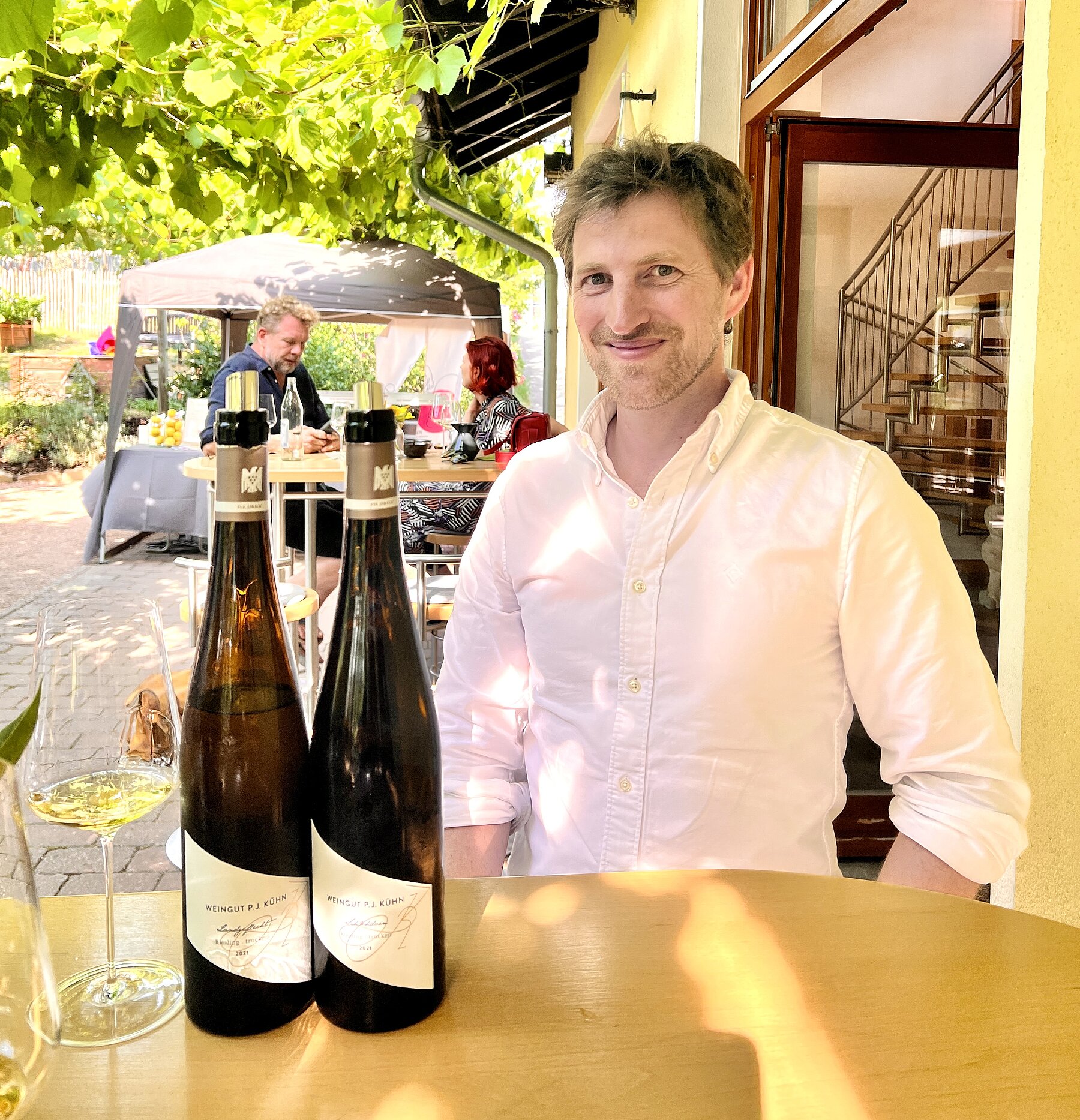
Bernhard Kühn has been at the helm of the winery for several years.
Even if the ratings don't express it so drastically at first glance and the 2023 vintage is possibly the best since 2019, there were some rather questionable wines that did not meet the VDP's own high grand cru standards.
If you haven't worked properly in the vineyard throughout the year and during the harvest, you have to make corrections in the cellar, which rarely goes well. The natural harmony is then missing and some wines appear "technically" well-made, but without the character of the vineyard and origin, which is propagated as a brand promise and sales argument in a "Grand Cru".
Unfortunately, I had questionable wines that left an impression of sweet and sour particularly often on the Moselle, which I appreciate and love so much. But in other regions, too, there were wines that could be described as well made, but which lacked substance, depth and (site) character.
As is common in many other countries, there is often a lack of will and courage to downgrade the wines in difficult vintages or to reduce the yields to such an extent that wines are produced that meet the high standards. In 2022, for example, Peter Bernhard Kühn gave up his Landgeflecht from the heart of the Doosberg because there was not enough for his rarity. An exception.
Winning regions of the year
For me, the winners of the 2023 vintage are once again the regions of Rheinhessen, Nahe and Pfalz. These three regions are almost alone in the top 10 places for Rieslings.
The best wines from Keller, Battenfeld-Spanier, Kühling-Gillot, Schäfer-Fröhlich, Dönnhoff, Emrich-Schönleber, Bürklin-Wolf and Rebholz can be found there. The Rheingau proved to be quite homogeneous without any major downward or upward outliers, with territorially cool mountain wines from the Gräfenberg (Weil) and Rüdesheimer Berg (above all Kühn'snew and Breuer's Schlossberg) and with Schloss Johannisberg, a great wine has made an impressive return to the top in recent years. However, most of the wines in the Rheingau were from 2022, as the Rheingau has completely postponed marketing by one year, which requires a differentiated assessment and raises the question of whether this really makes sense, especially in such diverse vintages as 2022 and 2023.
The Moselle was heterogeneous and rather weak overall. Only the well-known top winemakers scored well here. However, there are brilliant Kabinett and Spätlese wines that deliver a great arc of tension and perhaps express the terroir better than almost any other dry wine. The best noble sweet wines are stunning.

The Moselle proved to be heterogeneous and rather weak overall. Only the well-known well-known top winegrowers. (© VDP)
The winning wines of the vintage
We scored up to the outstanding mark of 98/100, which was achieved by six wines this year: Keller'senergetic Abtserde and Pettenthal, which is certainly one of the best ever, left me breathless. The FINAL from Tim Fröhlich, who delivered one of the best collections despite the new cellar building, is on a par. His Felseneck also plays in the very top league. These vintage winners also include three wines from Hans Oliver Spanier. From his very own limestone terroir, he has chiseled two touching wines from the Frauenberg (97/100) and from the red clay-slate terroir of the Rothenberg (98/100), which gave me pause due to their effortless elegance. The Rothenberg is an exciting, minerally, powerful, territorial Riesling from the Roter Hang, which showed what world-class wines can be produced from the otherwise drought-stricken Roter Hang when the vines are given water. Then there is the magnificent Kreuzberg, which grows in the Zellertal on the border with Rheinhessen but belongs to the Palatinate.
In the Rheingau, Peter Jakob Kühn achieved this attribute with the spectacular first wine from the Rüdesheimer Schlossberg (98/100).
Two other wines from Rheinhessen were also awarded the grandiose score of 97/100. Wittmann's powerful Morstein, which I have never experienced so strongly - an equally great, territorial Riesling of impressive precision, and Kühling-Gillot's Pettenthal. The following wines from the Palatinate are in the Champions League. Rebholz's highly elegant, relaxed Kastanienbusch, Christmann's phenomenally precise and sharply contoured Idig and the no less grandiose Ölberg as well as Battenfeld-Spanier's Kreuzberg (see above). The Nahe scores here with the mineral-smoky Auf der Ley from Emrich-Schönleber, which is even better than last year.
Ten wines still achieve 96/100. They deserve the attribute "world class". 93-95/100 are also outstanding wines that are among the best in the country and should be included on your shopping list. This is where the biggest difference to the previous year can be found. There are significantly fewer wines that have achieved this score. I think Rheinhessen is even a tick ahead of the Nahe at the top this year. Most of the winning wines come from here, with the Roter Hang in particular finally benefiting from the good water supply. But top wines also came from the top Wonnegau sites such as Morstein and Brunnenhäuschen .
In the Palatinate, which was mainly handled by my colleague Jürgen Mathäß this year, the picture was split in two: The winners came from the Southern Palatinate and the Northern Palatinate; from the famous Mittelhardt, Bürklin-Wolf and Reichsrat von Buhl were almost the only ones to impress. Rings also once again delivered many great wines - in white and red - and is establishing itself at the top of the Palatinate. A great rise for the two Rings brothers. Pfeffingen scratched the 96-point mark with the Weilberg.
In the Rheingau, Kühn's Doosberg and its premiere vintage from the Rüdesheimer Berg Schlossberg won the 2023s together with Schloss Johannisberg's Goldlack (96/100) and Weil's Monte Vacano (96/100), which I was only allowed to taste from the barrel and now bottled. Among the 2023s, Kühn's Schlossberg took the cake with 98/100.
In general, his collection is the best in the Rheingau. It is closely followed in the ranking by Weil's Gräfenberg, which has never been so powerful and tightly meshed.
Achim von Oetinger and Andreas Spreitzer and Gunther Künstler also delivered. Breuer's steep-slope wines benefited from the good water supply and are balanced and typical of the site.
White and red Pinots - a new dimension?
2023 is also a very good year for the white Pinots, as the early varieties were not quite as affected by the persistent rainfall. It is noticeable that the reduction notes, which often seem artificial, have been reduced somewhat. The wood is also used more delicately. While these wines have become increasingly "Burgundian" in recent vintages, with a smooth, silky elegance, the trend towards a unique interpretation of white Burgundy is continuing, with a lively race and a certain grip on the finish. Dr. Wehrheim and Rebholz from the Palatinate and Huber and Heger from Baden are still leading the way, but Franz Keller and Salwey also produce wonderful white (and red) Burgundy wines.
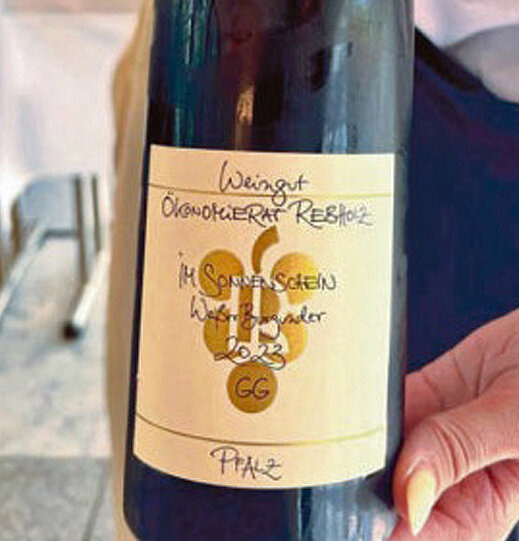
The best white Burgundy comes from the Rebholz winery in the Palatinate.
Abundance of top Pinot Noirs
For the 2022 red Pinots, the biggest challenge for the winegrowers was usually to get the Pinot Noir grapes off the vine at the right time, i.e. "al dente", so to speak, whereby such great ripening has rarely been possible despite global warming.
But it was not only the weather conditions that ensured that 2022 produced such an abundance of excellent Pinot Noirs as never before.
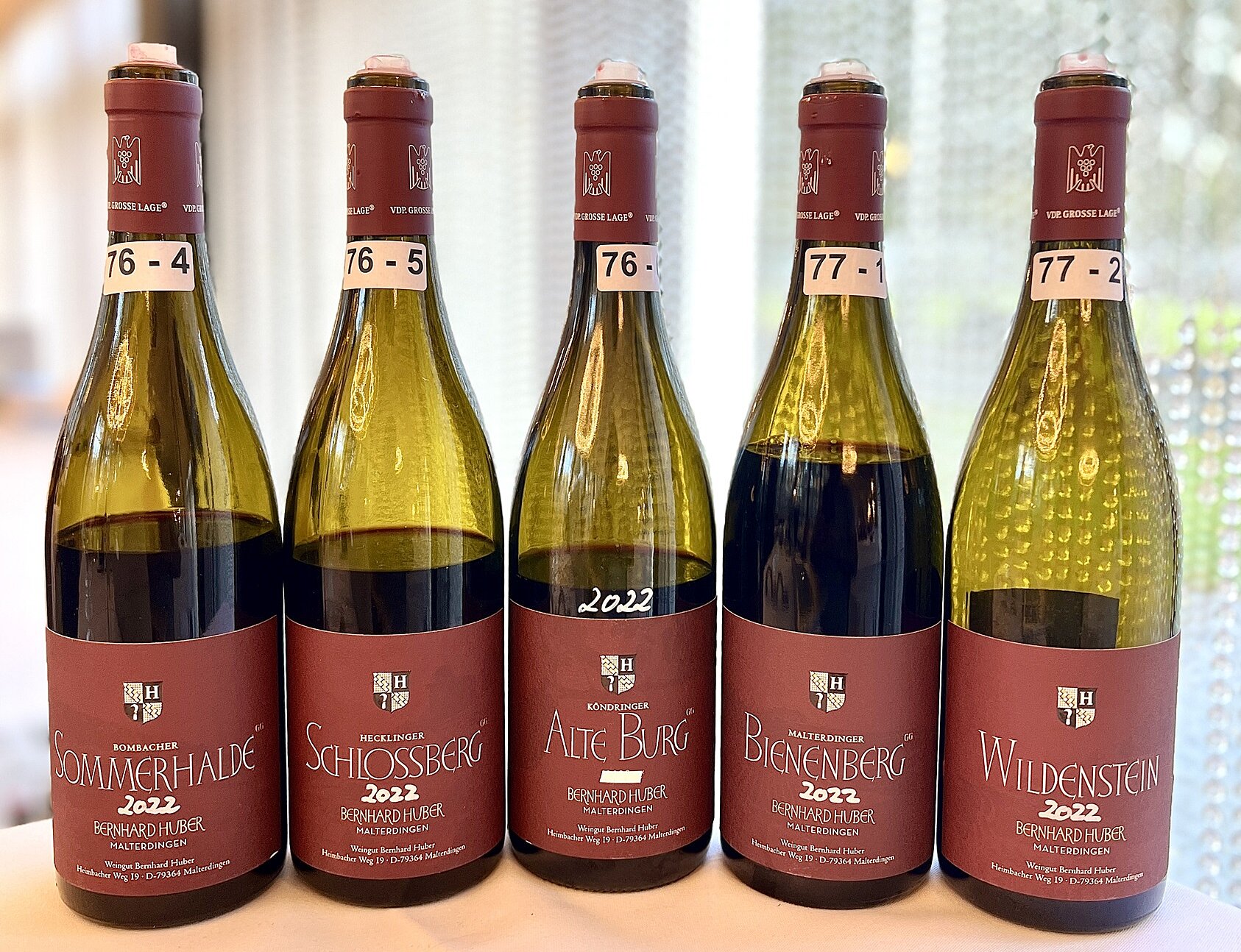
Certainly the best red wine collection in the history of the winery is also the best in Germany.
The favorable vintage was merely nature's template, which then had to be brought into the bottle in top quality with the appropriate winemaking skills. In fact, more top wineries than ever before (but by no means all of them!) were able to take advantage of this opportunity. Never before have German Pinots shown so much flair for vinification, wood integration, acid balance and tannin polish. You can sense the potential here when remarkable winemaking skills meet optimal conditions. Pinot is a game of patience. So is the experience in dealing with this diva. Germany's top winemakers now seem to be ready to interpret this challenge at a top international level. All the more noticeable, however, were those wines that continued to rely on over-extraction instead of balance, power instead of harmony, spice instead of fruit, volume instead of finesse and apparent internationality instead of authenticity
.
The tasting of the 2022 Pinot Noirs revealed another very remarkable aspect: it is precisely where the balance of the Pinot and the finesse of the vinification are at their highest that the typicity of the terroir seems to be best expressed. We are therefore approaching terroir-related origins instead of generally speaking of "German" Pinot Noir. This is because the best growths from Franconian sandstone are just as unmistakable as those from the weathered limestone of Breisgau or the volcanic rock of Kaiserstuhl. And so today, Fürst's Hundsrück, Huber's Wildenstein and Keller's Morstein "Felix" are three world-class wines that are probably the best Pinot Noirs ever produced in Germany.
Conclusion: Super top, solid midfield, weak substructure
At the top, we have rarely had such an abundance of great wines and scored so highly. Five times 98/100 for the dry whites and three times 96/100 for the reds were quite rare. In the best cases, the ripeness of the vintage is combined with the freshness that the more balanced year offered. The top wines offer depth, complexity, substance, length and, above all, show what they promise: Origin, or at least recognizability, combined with a grandiose territorial expression. Rarely have we seen such a spread of points. However, this should not obscure the fact that we are talking about around 10 to 15 wineries with around 30 to 50 wines. There are not many more, but the good news is that there are more and more. 2023 requires both top terroirs with a tendency towards draining soils and winemaking skills with fanaticism for quality in order to produce top wines.
There were actually a few examples of this that will show their great class in a few years' time. Unfortunately, there are also some wines that are only technically solid but somehow also a little soulless and do not meet the GG standard.
"You could produce top wines in 2023 with low yields," says Peter Jakob Kühn confidently. Or as Tim Fröhlich said in an exclusive interview with me: "A year of diligence and consistency". The wines have a good freshness in all predicate levels, which is a welcome change from previous vintages. My impression is that it was a good year for Kabinett and Spätlese wines, especially on the Moselle, as some of the wines tasted at the auction showed. Some Kabinett and Spätlese wines were superior to the GGs: incredibly playful and elegant, full of finesse. Such as Prüm's magnificent Kabinett from the Wehlener Sonnenuhr or from Clemens Busch. "It was another Kabinett and Spätlese year, if you read these predicates first. Then it became more complicated," said Busch. In any case, his wines were among the best on the Moselle.
Best of RIESLING - TOP 75
98/100
- 2023 Riesling "Final" (auction), Schäfer-Fröhlich, Nahe
- 2023 Nackenh. Rothenberg Riesling GG, Kühling-Gillot, Rheinhessen
- 2023 Westhofener Absterde Riesling GG, Keller, Rheinhessen
- 2023 Rüdesheimer Berg Schlossberg Riesling GG (barrel sample), Peter Jakob Kühn, Rheingau
- 2023 Niersteiner Pettenthal Riesling GG, Keller, Rheinhessen
96-97/100
- 2023 Westhofener Morstein Riesling GG, Wittmann, Rheinhessen
- 2023 "Auf der Ley" Riesling GG, Emrich-Schönleber, Nahe
- 2023 Oestricher Doosberg Riesling GG, Peter Jakob Kühn, Rheingau
- 2023 Niederflörsheimer Frauenberg Riesling GG, Battenfeld-Spanier
- 2023 Niersteiner Pettenthal Riesling GG, Kühling-Gillot, Rheinhessen
- 2023 Kastanienbusch Riesling GG, Ökonomierat Rebholz, Palatinate
- 2023 Königsbacher Ölberg-Hart Riesling GG, A. Christmann, Palatinate
- 2023 Riesling Kreid, Rings, Palatinate
- 2023 "CO" Riesling Steinlinden "Liquid Earth", Battenfeld-Spanier
- 2023 Zeller "Kreuzberg" Riesling GG , Battenfeld-Spanier, Palatinate
96/100
- 2023 Königsbacher Idig Riesling GG, A. Christmann, Palatinate
- 2023 Pündericher Marienburg Rothenpfad Riesling GG, Clemens Busch, Mosel
- 2023 Schubertslay Riesling GG, Keller, Mosel
- 2021 Schloss Johannisberg Riesling Goldlack, Rheingau
- 2023 Bockenauer Felseneck Riesling GG, Schäfer-Fröhlich, Nahe
- 2022 Monte Vacano, Robert Weil, Rheingau
- 2023 Monte Nostrum, Riesling, Robert Weil, Rheingau
- 2023 Niederhausener Hermannshöhle Riesling GG, H. Dönnhoff, Nahe
- 2023 St. Nikolaus Riesling GG, Peter Jakob Kühn, Rheingau
- 2023 Forster Pechstein Riesling GG, Dr. Bürklin-Wolf, Palatinate
95+/100
- 2023 Kiedricher Gräfenberg Riesling GG, Robert Weil, Rheingau
- 2023 Berg Schlossberg Riesling, Breuer, Rheingau
- 2023 Westhofener Morstein Riesling GG, Keller, Rheinhessen
- 2023 Oberhausener Brücke Riesling GG (Verst.), Dönnhoff, Nahe
- 2023 Riesling Alte Reben LA BORNE (dist.), Wittmann, Rheinhessen
- 2023 Kallstadter Saumagen Riesling GG, Rings, Pfalz
- 2023 Fenchelberg Riesling GG (dist.), Gunderloch, Rheinhessen
- 2022 Forster Pechstein Riesling GG, Reichsrat von Buhl, Palatinate
- 2023 Im Sonnenschein Riesling GG, Ökonomierat Rebholz, Palatinate
- 2023 Birkweiler Kastanienbusch Riesling GG, Dr. Wehrheim, Palatinate
- 2022 Schweigener Sonnenberg Riesling GG, Friedrich Becker, Palatinate
- 2023 Uhlen "Laubach" Riesling GG, Heymann-Löwenstein, Mosel
- 2022 Mittelheimer St. Nikolaus Riesling GG, P. Jakob Kühn, Rheingau
95/100
- 2023 Zeller Philippsbrunnen, Riesling GG (Verst.), Philipp Kuhn
- 2023 Laumersheimer Steinbuckel Riesling GG, Knipser, Pfalz
- 2023 Kallstadter Saumagen Riesling GG, Philipp Kuhn, Pfalz
- 2023 Forster Kirchenstück Riesling GG (barrel sample), von Winning, Pfalz
- 2022 Forster Kirchenstück Riesling GG, Reichsrat von Buhl, Palatinate
- 2022 Ruppertsberger Reiterpfad - Hofstück Riesling GG, R. von Buhl
- 2023 Im Sonnenschein Ganz Horn Riesling GG, Ökonom. Rebholz
- 2023 Ilbesheimer Kalmit Riesling GG, Kranz, Pfalz
- 2023 Schweigener Sonnenberg Riesling GG, Jülg, Palatinate
- 2023 Ayler Lambertskirch (auction) Riesling GG, Peter Lauer, Saar
- 2023 Lieser Niederberg Helden, Riesling GG, Schloss Lieser, Mosel
- 2023 Brauneberger Juffer-Sonnenuhr Riesling GG, Fritz Haag, Mosel
- 2023 Uhlen "Blaufüsser Lay" Riesling GG, Heymann-Löwenstein, Mosel
- 2022 Oestricher Doosberg Riesling GG, Peter Jakob Kühn, Rheingau
- 2022 Erbacher Marcobrunn Riesling GG, von Oetinger, Rheingau
- 2023 Hattenheimer Wisselbrunnen Riesling GG, Spreitzer, Rheingau
- 2023 Monzinger Halenberg Riesling GG, Emrich-Schönleber, Nahe
- 2023 Monzinger Halenberg Riesling GG, Schäfer-Fröhlich, Nahe
- 2023 Oberer Hubacker Riesling GG, Keller, Rheinhessen
- 2023 Westh. Brunnenhäuschen Riesling GG, Wittmann, Rheinhessen
- 2023 Am Schwarzen Herrgott Riesling GG, Battenfeld-Spanier, Rheinh.
- 2023 "EMT" Riesling (Verst.), Wagner-Stempel, Rheinhessen
- 2022 Riesling Brühl, VDP. Auktion.Réserve, von Oetinger
- 2023 Niersteiner Hipping Riesling GG, Keller, Rheinhessen
- 2023 Bockenauer Stromberg Riesling GG, Schäfer-Fröhlich, Nahe
- 2023 Monz. Frühlingsplätzchen Riesling GG, Schäfer-Fröhlich, Nahe
- 2023 Ungsteiner Weilberg Riesling GG, Pfeffingen, Pfalz
- 2023 Bürgergarten im Bäumel Riesling GG, Müller-Catoir, Palatinate
- 2023 Forster Pechstein Riesling GG, Georg Mosbacher, Palatinate
93-94/100
- 2023 Zeller Schwarzer Herrgott Riesling GG, Philipp Kuhn, Palatinate
- 2023 Ruppertsberger Gaisböhl Riesling GG, Dr. Bürklin-Wolf, Palatinate
- 2023 Forster Pechstein Riesling GG (barrel sample), von Winning, Pfalz
- 2023 Ayler Kupp Riesling GG, Peter Lauer, Saar
- 2023 Scharzhofberger Pergentsknopp Riesling GG, Van Volxem, Saar
- 2023 Piesporter Goldtröpfchen Riesling GG, Schloss Lieser, Mosel
- 2023 Marienburg Fahrlay Terrassen Riesling GG, Clem. Busch, Moselle
- 2023 Marienburg Falkenlay Riesling GG, Clemens Busch, Mosel
- 2023 Uhlen "Roth Lay" Riesling GG, Heymann-Löwenstein, Mosel
- 2022 "Silberlack" Riesling GG, Schloss Johannisberg, Rheingau
- 2022 Hallgartener Jungfer Riesling GG, Peter Jakob Kühn, Rheingau
- 2022 Hochheimer Hölle Riesling GG, Künstler, Rheingau
- 2023 Norheimer Dellchen Riesling GG, H. Dönnhoff, Nahe
- 2023 Dorsheimer Goldloch Riesling GG, Schlossgut Diel, Nahe
- 2023 Appenheimer Hundertgulden Riesling GG, Bischel, Rheinhessen
- 2023 Siefersheimer Heerkretz Riesling GG, Bischel, Rheinhessen
- 2023 Niersteiner Pettenthal Riesling GG, Gunderloch, Rheinhessen
- 2023 Niersteiner Hipping Riesling GG, Kühling-Gillot, Rheinhessen
- 2023 Westhofener Kirchspiel Riesling GG, Wittmann, Rheinhessen
- 2023 Westhofener Kirchspiel Riesling GG, Keller, Rheinhessen
- 2023 Niersteiner Hipping Riesling GG, Battenfeld-Spanier, Rheinhessen
- 2023 Westhofener Morstein Riesling GG, K.F. Groebe, Rheinhessen
Best of SPÄTBURGUNDER - TOP 10
96/100
- 2022 Bürgstadt HUNDSRÜCK Rudolf Fürst, Franconia
- 2022 BIENENBERG WILDENSTEIN Bernhard Huber, Baden
- 2022 Westhofener Morstein "Felix", Keller, Rheinhessen
95/100
- 2022 Malterdingen BIENENBERG Bernhard Huber, Baden
- 2022 Bürgstadt CENTGRAFENBERG Rudolf Fürst, Franconia
- 2022 Hecklingen SCHLOSSBERG Bernhard Huber, Baden
93-94/100
- 2021 Schweigen HEYDENREICH Friedrich Becker, Palatinate
- 2022 Köndringen ALTE BURG, Bernhard Huber, Baden
- 2022 Klingenberg SCHLOSSBERG Rudolf Fürst, Franconia
➜ As a subscriber, you will find the tasting notes of the best GGs in our brand new database with optimized search function.
